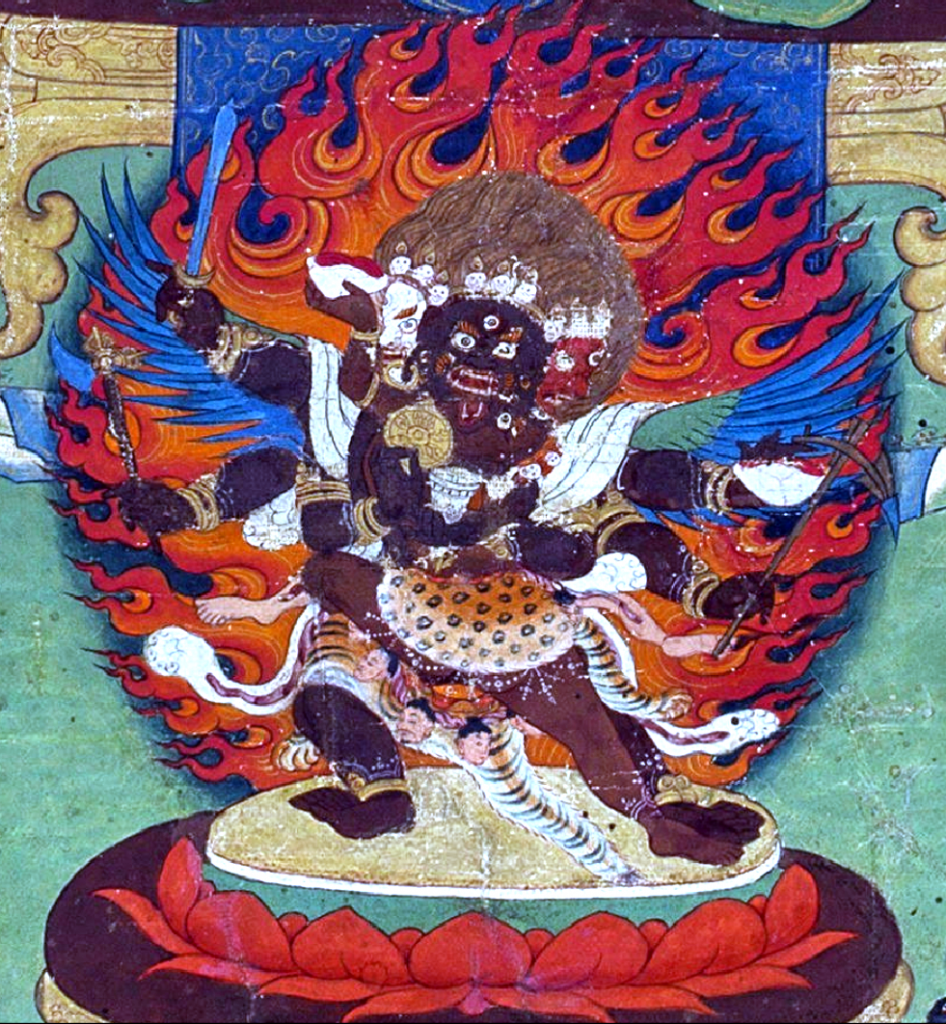Bardo Tödröl Chenmo (Tibetan: bar do thos grol chen mo): ‘The ‘Great Liberation through Hearing an Elucidation of the Intermediate State of Reality’ (i.e. ‘The Tibetan Book of the Dead‘) an extract from the ‘Peaceful and Wrathful Deities: The Profound Teaching on Natural Liberation through Recognition of the Primordial State. ‘
“It is the teaching whereby liberation can be attained without meditation… whereby liberation can be won by hearing.”
May all find refuge on the path of liberation.
Prologue
“The ‘Great Liberation through Hearing’, “the method that liberates yogis of middling capacity during intermediate states…”
Is of three parts:
I. Premise
II. Instructions
III. Conclusion
I. Premise
“Methods by which beings of physical body can achieve liberation… [to be] repeatedly read during the intermediate states… with correct pronunciation and clear dictation.”
II. Instructions
- Offerings to Three Supreme Jewels
- Invocations, Root Verses read aloud
- Bardo Thodo Instructions read aloud
Bardo Thodo “Instructions are of three parts:
Introduction to the…
- Clear Light
- Intermediate State of Reality
- Intermediate State of Rebirth
1. Introduction to the Clear Light in the Intermediate State of the Moment of Death
“Attaining the unborn enlightened dimension of the dharmakāya.”
Is of two parts:
-
- Introduction to the Clear Light of the Base
- “Recognize the brilliant essence of your own awareness as buddha nature”
- Introduction to the Clear Light of the Path
- Focus intently on your meditation deity/Mahakarunika
- Introduction to the Clear Light of the Base
2. Introduction to Recognizing the Intermediate State of Reality
“Recognize all that appears as pure awareness, naturally manifesting…”
The Vision of the Peaceful Deities in the Intermediate State of Reality…
Wherein Manifests:
- First Day: Blue light of Space, wisdom of expansive reality. From central Pervasive Sphere, White Vairocana on Lion Throne with vajra and consort Ākāsadhātvìśvari.
- Second Day: White light of Water, mirrorlike wisdom. From eastern Perfect Joy realm, Blue Aksobhya-Vajrasattva on Elephant Throne with vajra and consort Buddhalocaña. Retinue, four within expanse of rainbow light.
- Third Day: Yellow light of Earth, equanimous wisdom. From southern Glorious Śrimat, Yellow Ratnasambhava on Horse Throne with jewel and consort Māmaki. Retinue, four within expanse of rainbow light.
- Fourth Day: Red light of Fire, wisdom of discrimination. From western Blissful Sukhāvatī, Red Amitābha on Peacock Throne with lotus flower and consort Pāndaravāsin. Retinue, four within expanse of rainbow light.
- Fifth Day: Green light of Air, action-accomplishing wisdom, from northern Perfect and Complete Enlightened Activities realm Green Amoghasiddhi on Civamcivaka Bird Throne with double vajra and consort Samayatāra. Retinue, four within expanse of rainbow light.
- Sixth Day: All Five Enlightened Families with retinues. Union of four wisdoms vision. Six dim lights of six realms of Samsara, “do not be enticed by them”: God (pallid white); Hell (murky); Human (pallid blue) Hungry Ghost (pallid yellow); Demigod (dim red); Animal (pallid green). The Wrathful Gatekeepers. The six nirmanakaya sages. Samanthabhdra and Samanthabhdri. “Recognize… your own pure vision. “
- Seventh Day: Light of five colors, purity of your tendencies in expansive reality and innate wisdom. Assembly of divine awareness holders from Pure Realm of the Skyfarers with attendant dakas and dākinīs, “to lead you with great love on the path of the radiant light of innate wisdom.”
The Vision of the Wrathful Deities in the Intermediate State of Reality…
Wherein “the blazing assembly of the fifty-eight wrathful [blood-drinking] herukas, who are transformations of the previous peaceful deities” appear. “Do not be afraid. Do not be terrified. Do not become bewildered. Recognize them [as your own meditation deity] and do not be distracted [dissolve inseparably into them, and thereby become enlightened].”
Wherein Manifests:
- Eighth Day: From within your own mind, blackish-brown in color Great Glorious Buddha Heruka with consort Buddhakroddhishvari
- Ninth Day: From the east, blackish-blue in color Vajra Heruka with consort Vajrakrodhishvari
- Tenth Day: From the south, blackish-yellow in color Ratna Heruka with consort Ratnakrodhishvari
- Eleventh Day: From the west, blackish-red in color Padma Heruka with consort Padmakrodhishvari
- Twelfth Day: From the north, blackish-green in color Karma Heruka with consort Karmakrodhishvari
- Thereafter: From within the mind, the eight wrathful female gaurī (symbols of the eight consciousnesses) will arise : white Gauri; yellow Cauri; red Pramohā; black Vetālī; reddish-yellow Pukkasī; blackish-green Ghasmarī; pale yellow Candālī; blackish-blue Samašāni. And the eight wrathful female piśācī (symbols of the eight objects of consciousnesses), with different animal heads, will arise: lion-head Simhamukhī; tiger-headed Vayāghrīmukhī; fox-headed Śrgālamukhī; wolf-headed Shvānamukhī; vulture-headed Grdhramukhī; kangka bird-headed Kankamukhī; crow-headed Kākamukhī; owl-headed Ulūkamukhī. Four female gatekeepers. Twenty-eight īśvarī (manifestations of the natural energy of your own pure awareness). Six yoginīs of the east, six yoginīs of the south, six yoginīs of the west, six yoginīs of the north, four yoginī gatekeepers. Through energy of emptiness, dharmakāya, manifested the Peaceful Deities. Through energy of clarity, sambogakāya, manifested the Wrathful Deities. Mahakala. Yama.
Conclusion of the Introduction to the Intermediate State of the Moment of Death and the Intermediate State of Reality
“It is extremely important to train the mind in the ‘Great Liberation Through Hearing’ while alive… It should be read aloud… to meet this teaching is a great fortune. Thus cherish it greatly.”
3. Introduction to the Intermediate State of Rebirth
“The intermediate state of reality arose within you, you did not recognize it, so you are compelled to wander here… recognize and sustain without distraction your own essential nature.”
Is of three parts:
- Introduction to the Mental Body
- “Your awareness without physical support, is buffeted by currents of vital energy of past actions”
- “Do not be afraid. This is your own illusory vision”
- “Be free of attachment and grasping”
- “Renounce yearning for a body, remain in a state of undistracted nonaction”
- “Dwell in contemplation of The Great Symbol”
- Obstructing Womb Entrances
- Maintain a strong resolve
- Unite propensities of past good deeds
- Recall methods of reversal
- Steadfastness and pure vision are vital
- Renounce jealousy, meditate on your spiritual teacher and consort
- Choosing a Womb Entrance
- It is crucial to keep in mind the meaning of emptiness, the essence of the Great Symbol
- Meditate on the Great Compassionate One, Mahakarunika (an epithet of Avalokiteśvara, the bodhisattva of compassion)
- “For the benefit of all beings, I shall be born a universal monarch…”
- Take refuge in the Three Precious Jewels. Invoke The Great Compassionate One. Give up all attachment
- Enter the blue light of the human realm, the white light of the god realm, the celestial palaces.
III. Conclusion
Wherein the “instruction[s] on the intermediate state that liberates mortal beings, the profound pure essence titled ‘Great Liberation through Hearing in the Intermediate States,'” is completed. “May it benefit the teaching and all sentient beings.”
Samaya! gya gya gya!
Padmasambhava; Lingpa, Karma. The Tibetan Book of the Dead . North Atlantic Books.



dharmakāya. (T. chos sku;). In Sanskrit, often translated as “truth body,” one of the two (along with the RŪPAKĀYA) or three (along with the SAṂBHOGAKĀYA and NIRMĀṆAKĀYA) bodies of a buddha. In early discussions of the true nature of the Buddha, especially regarding the person of the Buddha to whom one goes for refuge (ŚARAṆA), the term dharmakāya seems to have been coined to refer to the corpus or collection (KĀYA) of the auspicious qualities (DHARMA) of the Buddha, including his wisdom, his compassion, his various powers, etc.; it also referred to the entire corpus (kāya) of the Buddha’s teachings (dharma). In the MAHĀYĀNA, the term evolved into a kind of cosmic principle that was regarded as the true nature of the Buddha and the source from which his various other forms derived. In the perfection of wisdom (PRAJÑĀPĀRAMITĀ) commentarial tradition, a dispute arose over the interpretation of the eighth chapter of the ABHISAMAYĀLAṂKĀRA, with VIMUKTISENA arguing that the SVĀBHĀVAKĀYA is the ultimate nature of a buddha and HARIBHADRA arguing that there are two aspects of the dharmakāya: a JÑĀNADHARMAKĀYA (knowledge truth body), i.e., the nondual omniscient knowledge of a buddha, and a svābhāvakāya. Later commentators in India and Tibet explored the ramifications of this distinction at length.